-
Notifications
You must be signed in to change notification settings - Fork 0
v0.4.0 Lab 1 Use CARML to deploy infrastructure
In this lab, you will learn how to use the modules that are currently available in the CARML library to build a basic, template-orchestrated solution - using local file paths.
- Step 1 - Download the code base
- Step 2 - Create solution file
- Step 3 - Build solution
- Step 4 - Stretch goal: Deploy solution
To start building a solution / workload, you first have to get access to the code base. One of the ways to do so is to perform the following steps:
-
Open the repository via the URL aka.ms/CARML

-
On the overview page, select
Releasesto the right, further navigate to version 0.4.0 and finally select theSource code (zip)link in theAssetssection of the release to trigger the repository to be downloaded as a compressed file.
-
Following the download, navigate to the downloaded file and extract it to a location of your choice (for example
C:/dev/CARML/lab1)
-
Next, we'd ask you to open the extracted folder in VSCode. You can achieve this in multiple ways:
Alternative 1: Using VSCode
-
Open Visual Studio Code and trigger the file explorer on the top left
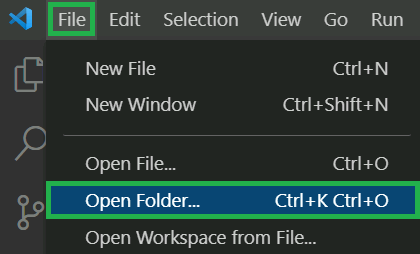
-
Navigate to the extracted folder, select it and trigger the
Select Folderbutton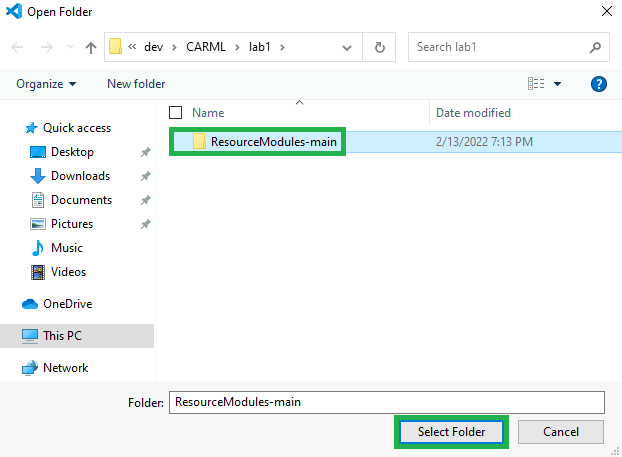
Alternative 2: Using the Terminal
-
Next, navigate to the inside of the extracted folder (e.g.
ResourceModules-main), perform a right-click and selectOpen in Windows Terminalto open a new PowerShell session with the path set to the current folder -
Next, just type & execute the command
code .to open Visual Studio Code in the extracted repository folder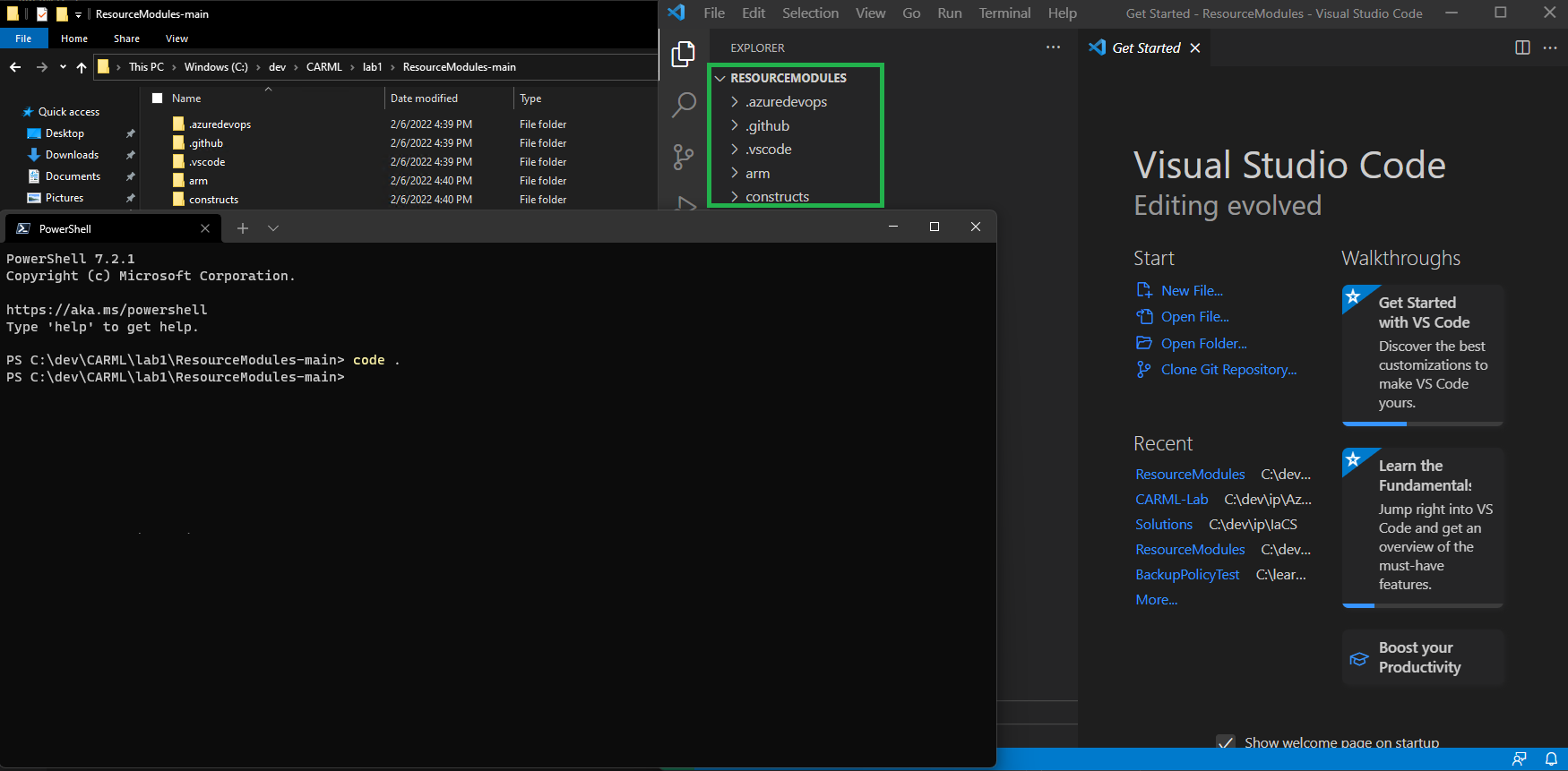
-
In Visual Studio, the next step is to create the solution itself. To do so, perform the following steps:
-
Create a folder called
workloadin the root folder by selecting the smallNew Folderbutton on the top of the file explorer in VSCode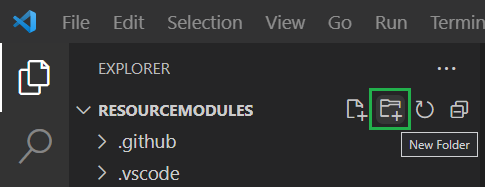
-
Then select the new folder and press the small
New Filebutton to the left of the previousNew Folderbutton and name itdeploy.bicep. This will be the folder where you create the workload.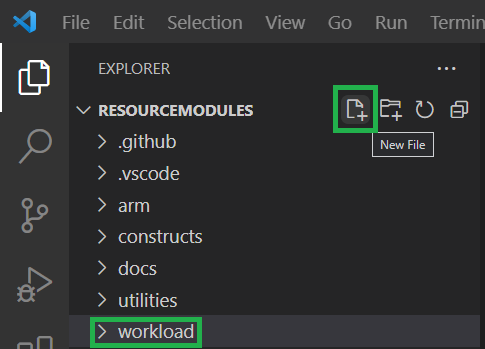
Now, let's create the actual solution. In this first lab, we will start with a small setup to get rolling.
Fundamentally, we want you to deploy
- A Resource Group
- A Storage Account
- A Key Vault
- A Log Analytics Workspace
To set these up, please perform the following steps:
-
Open the created workload file in
workload/deploy.bicep -
As you will deploy a resource group, we first need to set the template scope to
subscription. To do so, add the following line on the top of the filetargetScope = 'subscription'
-
Next, add the following parameters to the template
// ========== // // Parameters // // ========== // @description('Required. The name of the resource group to deploy') param resourceGroupName string = 'carml-rg' @description('Optional. The location to deploy into') param location string = deployment().location @description('Required. The name of the storage account to deploy') param storageAccountName string @description('Required. The name of the key vault to deploy') param keyVaultName string @description('Required. The name of the log analytics workspace to deploy') param logAnalyticsWorkspaceName string
-
Now, you will add the references to the individual CARML modules you will deploy. Let's start with the resource group. Underneath the parameters, add the following block
// =========== // // Deployments // // =========== // module rg '../arm/Microsoft.Resources/resourceGroups/deploy.bicep' =
The above snippet references the local path to the ResourceGroup CARML module. Thanks to Bicep's ability to resolve the reference, it should open a pop-up and ask you whether you want to auto-insert the
required parameters(if it does not come up automatically, try to remove & add the=, or pressCtrl + Space). PressEnterto confirm. These parameters are the ones the Bicep module does not have default values for.
Once confirmed, it will generate the following skeleton:
module rg '../arm/Microsoft.Resources/resourceGroups/deploy.bicep' = { name: params: { name: } }
As you can see, the module only requires you to provide a deployment
name(that will be visible in the list of deployments in the portal), as well as anamein its parameter block - referring to the resource group name. Please add a deployment name of your choice and reference theresourceGroupNametemplate parameter for the resource group'name'param. If you want to know what other parameters would be supported, feel free to check up on the module'sreadme.mdthat is located in the same folder as the template itself (for examplearm\Microsoft.Resources\resourceGroups\readme.md).By default, the resource group is deployed into the same location as the deployment. For the sake of this lab, please add an additional parameter
locationin theparamsblock of the module. Here you will reference the location that is defined as an input parameter in this template's parameter block above.Following you can find an example of how a complete reference would look like:
module rg '../arm/Microsoft.Resources/resourceGroups/deploy.bicep' = { name: 'workload-rg' params: { name: resourceGroupName location: location } }
Now, please fill in the parameters accordingly.
-
Following the same flow, please now go ahead and add the references to the
../arm/Microsoft.Storage/storageAccountsCARML module underneath the resource group module. Once done, it should look similar to:module sa '../arm/Microsoft.Storage/storageAccounts/deploy.bicep' = { scope: name: 'workload-sa' params: { name: storageAccountName } }
The part that is missing is the
scope. As we want to deploy the storage account into the resource group above and as such into a resource group scope, we must set that reference in the storage account scope. To do so, complete thescope:line withscope: resourceGroup(resourceGroupName)
Note: In case you are wondering why we don't use
scope: rgorscope: rg.outputs.nameto reduce the dependency on the input parameter: Both variants are not (yet) supported in Bicep.Note: If you're using the latest Bicep version, Linter will warn you to explicitly specify the location parameter. You can either comply and add the location parameter to each module deployment in the template, or ignore the warning.
As there is no direct reference to the resource group deployment (which has to come first) you also have to add an explicit dependency to the mix. To do so, add the following snippet in between the two final closing brackets
}of the storage account block:dependsOn: [ rg ]
The full module reference should now look like
module sa '../arm/Microsoft.Storage/storageAccounts/deploy.bicep' = { scope: resourceGroup(resourceGroupName) name: 'workload-sa' params: { name: storageAccountName } dependsOn: [ rg ] }
-
For the remaining two resources, Key Vault & Log Analytics Workspace, apply the same steps as you did for the storage account.
-
To also get some insights into the resources that are deployed, let's add some outputs as well. To do so, add the following lines to the end of the file:
// ======= // // Outputs // // ======= // @description('The resource ID of the deployed resource group') output resourceGroupResourceId string = rg.outputs.resourceId @description('The resource ID of the deployed storage account') output storageAccountResourceId string = sa.outputs.resourceId @description('The resource ID of the deployed key vault') output keyVaultResourceId string = kv.outputs.resourceId @description('The resource ID of the deployed log analytics workspace') output logAnalyticsWorkspaceResourceId string = law.outputs.resourceId
-
In total, the final result should look similar to. When done, make sure to save the file.
targetScope = 'subscription' // ================ // // Input Parameters // // ================ // @description('Required. The name of the resource group to deploy') param resourceGroupName string @description('Optional. The location to deploy into') param location string = deployment().location @description('Required. The name of the storage account to deploy') param storageAccountName string @description('Required. The name of the key vault to deploy') param keyVaultName string @description('Required. The name of the log analytics workspace to deploy') param logAnalyticsWorkspaceName string // =========== // // Deployments // // =========== // module rg '../arm/Microsoft.Resources/resourceGroups/deploy.bicep' = { name: 'workload-rg' params: { name: resourceGroupName location: location } } module sa '../arm/Microsoft.Storage/storageAccounts/deploy.bicep' = { scope: resourceGroup(resourceGroupName) name: 'workload-sa' params: { name: storageAccountName } dependsOn: [ rg ] } module kv '../arm/Microsoft.KeyVault/vaults/deploy.bicep' = { scope: resourceGroup(resourceGroupName) name: 'workload-kv' params: { name: keyVaultName } dependsOn: [ rg ] } module law '../arm/Microsoft.OperationalInsights/workspaces/deploy.bicep' = { scope: resourceGroup(resourceGroupName) name: 'workload-law' params: { name: logAnalyticsWorkspaceName } dependsOn: [ rg ] } // ======= // // Outputs // // ======= // @description('The resource ID of the deployed resource group') output resourceGroupResourceId string = rg.outputs.resourceId @description('The resource ID of the deployed storage account') output storageAccountResourceId string = sa.outputs.resourceId @description('The resource ID of the deployed key vault') output keyVaultResourceId string = kv.outputs.resourceId @description('The resource ID of the deployed log analytics workspace') output logAnalyticsWorkspaceResourceId string = law.outputs.resourceId
In this final step, we ask you to optionally perform a test deployment of the given template to ensure that everything works as intended. To do so, just perform the following steps:
-
Select the PowerShell
Terminalthat should be open on the lower end of VSCode. IfTerminalis not in sight, you can alternatively open it by expanding theTerminal-dropdown on the top, and selectingNew Terminal
-
Now, you have to run a few commands in succession. First, log into your Azure subscription by executing
Connect-AzAccountand follow the process -
Next, you can invoke the deployment itself. To do so, you can execute the following command using your own values for everything marked by
<x>:$inputObject = @{ DeploymentName = "CARML-workload-$(-join (Get-Date -Format 'yyyyMMddTHHMMssffffZ')[0..63])" TemplateFile = '<FullPathToYourTemplateFile>' # Get the path via a right-click on the template file in VSCode & select 'Copy Path' Location = '<LocationOfYourChoice>' # E.g. WestEurope Verbose = $true resourceGroupName = '<NameOfTheResourceGroup>' # E.g. workload-rg storageAccountName = '<NameOfTheStorageAccount>' # Must be globally unique keyVaultName = '<NameOfTheKeyVault>' # Must be globally unique logAnalyticsWorkspaceName = '<NameOfTheLogAnalyticsWorkspace>' # E.g. carml-law } New-AzSubscriptionDeployment @inputObject
The resulting log should look similar to:
PS C:\Desktop\CARML\ResourceModules> Connect-AzAccount Account SubscriptionName TenantId Environment ------- ---------------- -------- ----------- carml@hotmail.de carml 00000000-0000-0000-0000-000000000000 AzureCloud PS C:\Desktop\CARML\ResourceModules> $inputObject = @{ >> DeploymentName = "CARML-workload-$(-join (Get-Date -Format 'yyyyMMddTHHMMssffffZ')[0..63])" >> TemplateFile = 'C:\Desktop\CARML\ResourceModules\workload\deploy.bicep' >> Location = 'WestEurope' >> Verbose = $true >> ResourceGroupName = 'carml-rg' >> StorageAccountName = 'carmllabsa' >> KeyVaultName = 'carmlLabsakv' >> logAnalyticsWorkspaceName = 'carmllaw' >> } PS C:\Desktop\CARML\ResourceModules> New-AzSubscriptionDeployment @inputObject VERBOSE: Using Bicep v0.4.1008 VERBOSE: VERBOSE: 18:09:23 - Template is valid. VERBOSE: 18:09:25 - Create template deployment 'CARML-workload-20220202T1802526927Z' VERBOSE: 18:09:25 - Checking deployment status in 5 seconds VERBOSE: 18:09:30 - Resource Microsoft.Resources/deployments 'workload-rg' provisioning status is running VERBOSE: 18:09:30 - Resource Microsoft.Resources/resourceGroups 'carml-rg' provisioning status is succeeded VERBOSE: 18:09:31 - Checking deployment status in 14 seconds VERBOSE: 18:09:45 - Resource Microsoft.Resources/deployments 'workload-rg' provisioning status is succeeded VERBOSE: 18:09:45 - Resource Microsoft.Resources/deployments 'workload-rg' provisioning status is succeeded VERBOSE: 18:09:45 - Checking deployment status in 16 seconds VERBOSE: 18:10:02 - Resource Microsoft.Resources/deployments 'workload-kv' provisioning status is running VERBOSE: 18:10:02 - Resource Microsoft.Resources/deployments 'workload-sa' provisioning status is running VERBOSE: 18:10:02 - Resource Microsoft.Storage/storageAccounts 'carmllabsa' provisioning status is running VERBOSE: 18:10:02 - Resource Microsoft.Resources/deployments 'workload-law' provisioning status is running VERBOSE: 18:10:02 - Checking deployment status in 15 seconds VERBOSE: 18:10:18 - Resource Microsoft.Resources/deployments 'workload-sa' provisioning status is succeeded VERBOSE: 18:10:18 - Resource Microsoft.Storage/storageAccounts 'carmllabsa' provisioning status is succeeded VERBOSE: 18:10:19 - Resource Microsoft.KeyVault/vaults 'carmlLabsakv' provisioning status is running VERBOSE: 18:10:19 - Resource Microsoft.Resources/deployments 'workload-sa' provisioning status is succeeded VERBOSE: 18:10:19 - Resource Microsoft.OperationalInsights/workspaces 'carmllaw' provisioning status is running VERBOSE: 18:10:19 - Checking deployment status in 14 seconds VERBOSE: 18:10:34 - Resource Microsoft.Resources/deployments 'workload-kv' provisioning status is succeeded VERBOSE: 18:10:34 - Resource Microsoft.KeyVault/vaults 'carmlLabsakv' provisioning status is succeeded VERBOSE: 18:10:34 - Resource Microsoft.Resources/deployments 'workload-kv' provisioning status is succeeded VERBOSE: 18:10:34 - Checking deployment status in 14 seconds VERBOSE: 18:10:50 - Resource Microsoft.Resources/deployments 'workload-law' provisioning status is succeeded VERBOSE: 18:10:50 - Resource Microsoft.OperationalInsights/workspaces 'carmllaw' provisioning status is succeeded VERBOSE: 18:10:50 - Resource Microsoft.Resources/deployments 'workload-law' provisioning status is succeeded Id : /subscriptions/00000000-0000-0000-0000-000000000000/providers/Microsoft.Resources/deployments/CARML-workload-20220202T1802526 927Z DeploymentName : CARML-workload-20220202T1802526927Z Get-Location : westeurope ProvisioningState : Succeeded Timestamp : 02.02.2022 17:10:47 Mode : Incremental TemplateLink : Parameters : Name Type Value ========================= ========================= ========== resourceGroupName String carml-rg Get-location String WestEurope storageAccountName String carmllabsa keyVaultName String carmlLabsakv logAnalyticsWorkspaceName String carmllaw Outputs : Name Type Value ================================= ========================= ========== resourceGroupResourceId String /subscriptions/00000000-0000-0000-0000-000000000000/resourceGroups/carml-rg storageAccountResourceId String /subscriptions/00000000-0000-0000-0000-000000000000/resourceGroups/carml-rg/providers/Microsoft.Storage/storageAccounts/carmllabsa keyVaultResourceId String /subscriptions/00000000-0000-0000-0000-000000000000/resourceGroups/carml-rg/providers/Microsoft.KeyVault/vaults/carmlLabsakv logAnalyticsWorkspaceResourceId String /subscriptions/00000000-0000-0000-0000-000000000000/resourceGroups/carml-rg/providers/Microsoft.OperationalInsights/workspaces/carmllaw DeploymentDebugLogLevel :
If ready, proceed to the next lab: Lab 2 - Setup environment
This wiki is being actively developed